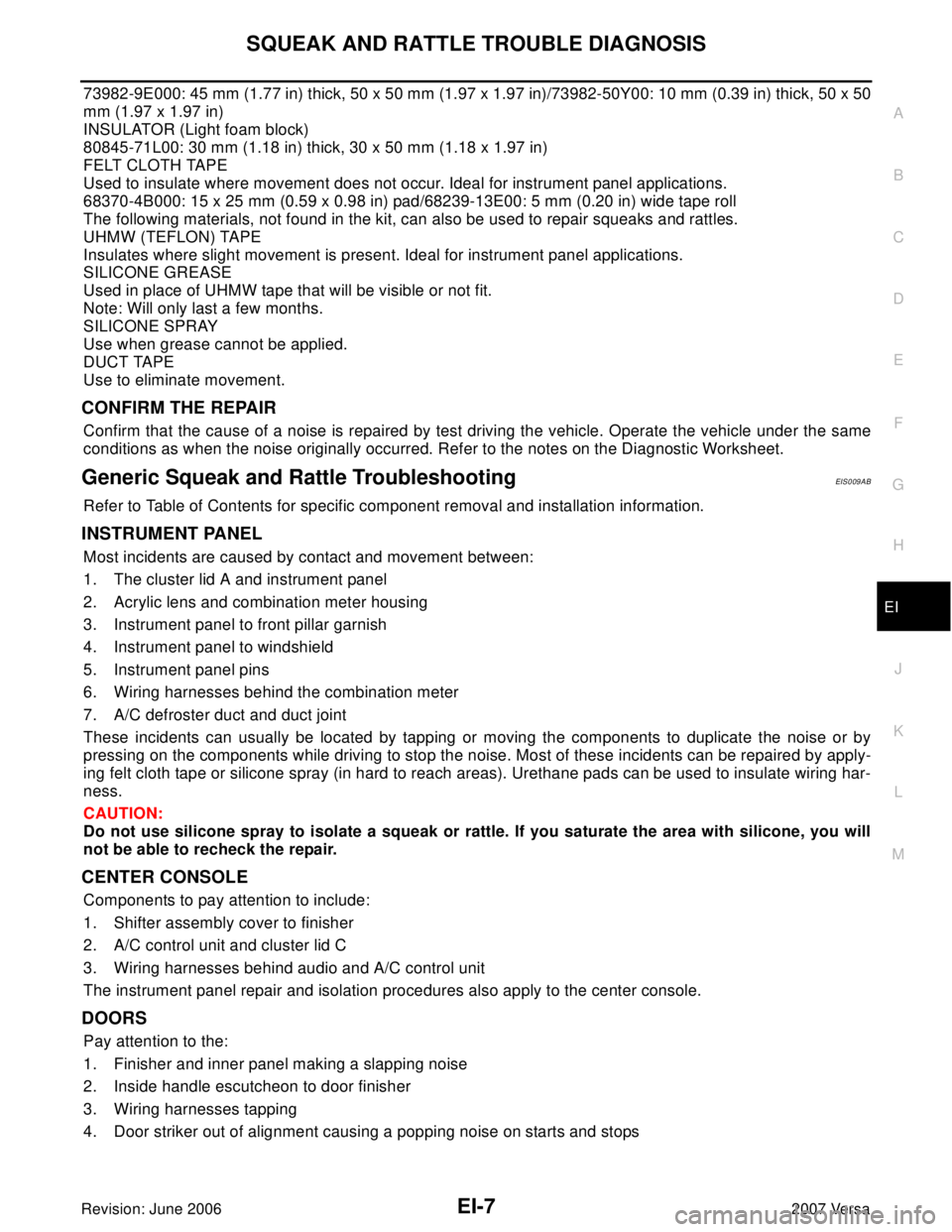Page 663 of 2896
BL-174
REAR DOOR LOCK
Revision: June 20062007 Versa
10. Slide the outside handle bracket toward the rear of vehicle,
remove the outside handle bracket and the door lock assembly.
11. If equipped, disconnect the door lock assembly electrical connector.
12. Disconnect the outside handle cable from the outside handle
bracket.
INSTALLATION
Installation is in the reverse order of removal.
CAUTION:
�To install each rod, be sure to rotate the rod holder until a click is felt.
�When installing door lock assembly, be careful when rotating the outside handle cable as shown.
–Place the outside handle bracket cable on the inside of door
lock assembly before installing.
PIIB6528E
PIIB5815E
PIIB6529E
Page 680 of 2896
BACK DOOR LOCK
BL-191
C
D
E
F
G
H
J
K
L
MA
B
BL
Revision: June 20062007 Versa
BACK DOOR HANDLE
Removal
1. Remove the back door finisher lower. Refer to EI-31, "BACK DOOR TRIM" .
2. Disconnect the harness connectors (1), remove the nuts and the
back door handle (A).
3. Release the clips and remove the switch from the housing.
Installation
Installation is in the reverse order of removal.
LIIA2669E
LIIA2609E
Page 720 of 2896
BODY REPAIR
BL-231
C
D
E
F
G
H
J
K
L
MA
B
BL
Revision: June 20062007 Versa
BODY REPAIRPFP:60100
Body Exterior Paint ColorEIS009AG
M: Metallic; 2S: 2-Coat Solid, 2P: 2-Coat Pearl; 3P: 3-Coat Pearl; G01-1: Material color; G02-1: Material color
LIIA2599E
ComponentColor code A20 B14 B23 K23 K36 KH3 QM1
Description Red AlertSapphire
BlueBlue OnyxBrilliant Sil-
verMagnetic
GreySuper
BlackFresh
Powder
Paint type 2S 2M 2M 2M 2M 2S S
Hard clear
coat–- –- –- –- –- –- –-
1Outside
mirrorBody color A20 B14 B23 K23 K36 KH3 QM1
2Radiator
grilleChromium-
plate + BlackCr2P +
G02-1Cr2P +
G02-1Cr2P +
G02-1Cr2P +
G02-1Cr2P +
G02-1Cr2P +
G02-1Cr2P +
G02-1
3Bumper
fasciaBody color A20 B14 B23 K23 K36 KH3 QM1
4Center
mudguard Body color/
BlackA20/G01-1 B14/G01-1 B23/G01-1 K23/G01-1 K36/G01-1 KH3/G01-1QM1/
G01-1
5Outside
handleBody color A20 B14 B23 K23 K36 KH3 QM1
6Rear pillar
trimBlack G01-1 G01-1 G01-1 G01-1 G01-1 G01-1 G01-1
7 Door sash Black tape X X X X X X X
Page 1772 of 2896

SQUEAK AND RATTLE TROUBLE DIAGNOSIS
EI-7
C
D
E
F
G
H
J
K
L
MA
B
EI
Revision: June 20062007 Versa
73982-9E000: 45 mm (1.77 in) thick, 50 x 50 mm (1.97 x 1.97 in)/73982-50Y00: 10 mm (0.39 in) thick, 50 x 50
mm (1.97 x 1.97 in)
INSULATOR (Light foam block)
80845-71L00: 30 mm (1.18 in) thick, 30 x 50 mm (1.18 x 1.97 in)
FELT CLOTH TAPE
Used to insulate where movement does not occur. Ideal for instrument panel applications.
68370-4B000: 15 x 25 mm (0.59 x 0.98 in) pad/68239-13E00: 5 mm (0.20 in) wide tape roll
The following materials, not found in the kit, can also be used to repair squeaks and rattles.
UHMW (TEFLON) TAPE
Insulates where slight movement is present. Ideal for instrument panel applications.
SILICONE GREASE
Used in place of UHMW tape that will be visible or not fit.
Note: Will only last a few months.
SILICONE SPRAY
Use when grease cannot be applied.
DUCT TAPE
Use to eliminate movement.
CONFIRM THE REPAIR
Confirm that the cause of a noise is repaired by test driving the vehicle. Operate the vehicle under the same
conditions as when the noise originally occurred. Refer to the notes on the Diagnostic Worksheet.
Generic Squeak and Rattle TroubleshootingEIS009AB
Refer to Table of Contents for specific component removal and installation information.
INSTRUMENT PANEL
Most incidents are caused by contact and movement between:
1. The cluster lid A and instrument panel
2. Acrylic lens and combination meter housing
3. Instrument panel to front pillar garnish
4. Instrument panel to windshield
5. Instrument panel pins
6. Wiring harnesses behind the combination meter
7. A/C defroster duct and duct joint
These incidents can usually be located by tapping or moving the components to duplicate the noise or by
pressing on the components while driving to stop the noise. Most of these incidents can be repaired by apply-
ing felt cloth tape or silicone spray (in hard to reach areas). Urethane pads can be used to insulate wiring har-
ness.
CAUTION:
Do not use silicone spray to isolate a squeak or rattle. If you saturate the area with silicone, you will
not be able to recheck the repair.
CENTER CONSOLE
Components to pay attention to include:
1. Shifter assembly cover to finisher
2. A/C control unit and cluster lid C
3. Wiring harnesses behind audio and A/C control unit
The instrument panel repair and isolation procedures also apply to the center console.
DOORS
Pay attention to the:
1. Finisher and inner panel making a slapping noise
2. Inside handle escutcheon to door finisher
3. Wiring harnesses tapping
4. Door striker out of alignment causing a popping noise on starts and stops
Page 1792 of 2896
DOOR FINISHER
EI-27
C
D
E
F
G
H
J
K
L
MA
B
EI
Revision: June 20062007 Versa
DOOR FINISHERPFP:80900
Removal and InstallationEIS0096V
FRONT DOOR
Removal
1. Open front door and front door window.
2. Disconnect the negative battery cable.
3. Release the front door inside handle escutcheon pawls, then
slide the escutcheon rearward to remove from front door fin-
isher.
1. Power window and door lock/unlock
switch finisher2. Front door finisher 3. Inside handle escutcheon
Clip C101
LIIA2572E
PIIB6040E
Page 1794 of 2896
DOOR FINISHER
EI-29
C
D
E
F
G
H
J
K
L
MA
B
EI
Revision: June 20062007 Versa
REAR DOOR
Removal
1. Open rear door and rear door window.
2. Disconnect the negative battery cable.
3. Release the rear door inside handle escutcheon pawls, then
slide the escutcheon rearward to remove from rear door finisher.
4. Insert a trim stick (A), or suitable tool into back edge of rear door
power window switch finisher. Lift upward to release the clips
and remove.
1. Rear power window switch finisher 2. Rear door finisher 3. Inside handle escutcheon
Clip C101
LIIA2573E
PIIB6040E
WIIA1238E
Page 2032 of 2896

SQUEAK AND RATTLE TROUBLE DIAGNOSES
GW-7
C
D
E
F
G
H
J
K
L
MA
B
GW
Revision: June 20062007 Versa
80845-71L00: 30 mm (1.18 in) thick, 30×50 mm (1.18×1.97 in)
FELT CLOTH TAPE
Used to insulate where movement does not occur. Ideal for instrument panel applications.
68370-4B000: 15×25 mm (0.59×0.98 in) pad/68239-13E00: 5 mm (0.20 in) wide tape roll. The following
materials not found in the kit can also be used to repair squeaks and rattles.
UHMW (TEFLON) TAPE
Insulates where slight movement is present. Ideal for instrument panel applications.
SILICONE GREASE
Used instead of UHMW tape that will be visible or not fit.
Note: Will only last a few months.
SILICONE SPRAY
Use when grease cannot be applied.
DUCT TAPE
Use to eliminate movement.
CONFIRM THE REPAIR
Confirm that the cause of a noise is repaired by test driving the vehicle. Operate the vehicle under the same
conditions as when the noise originally occurred. Refer to the notes on the Diagnostic Worksheet.
Generic Squeak and Rattle TroubleshootingEIS009E0
Refer to Table of Contents for specific component removal and installation information.
INSTRUMENT PANEL
Most incidents are caused by contact and movement between:
1. The cluster lid A and instrument panel
2. Acrylic lens and combination meter housing
3. Instrument panel to front pillar garnish
4. Instrument panel to windshield
5. Instrument panel mounting pins
6. Wiring harnesses behind the combination meter
7. A/C defroster duct and duct joint
These incidents can usually be located by tapping or moving the components to duplicate the noise or by
pressing on the components while driving to stop the noise. Most of these incidents can be repaired by apply-
ing felt cloth tape or silicone spray (in hard to reach areas). Urethane pads can be used to insulate wiring har-
ness.
CAUTION:
Do not use silicone spray to isolate a squeak or rattle. If you saturate the area with silicone, you will
not be able to recheck the repair.
CENTER CONSOLE
Components to pay attention to include:
1. Shifter assembly cover to finisher
2. A/C control unit and cluster lid C
3. Wiring harnesses behind audio and A/C control unit
The instrument panel repair and isolation procedures also apply to the center console.
DOORS
Pay attention to the:
1. Finisher and inner panel making a slapping noise
2. Inside handle escutcheon to door finisher
3. Wiring harnesses tapping
4. Door striker out of alignment causing a popping noise on starts and stops
Tapping or moving the components or pressing on them while driving to duplicate the conditions can isolate
many of these incidents. You can usually insulate the areas with felt cloth tape or insulator foam blocks from
the NISSAN Squeak and Rattle Kit (J-43980) to repair the noise.
Page 2071 of 2896

GW-46
FRONT DOOR GLASS AND REGULATOR
Revision: June 20062007 Versa
�Removal and installation of the door glass.
�Removal and installation of the door glass run.
Initialization
After installing each component to the vehicle, follow the steps below.
1. Disconnect the battery negative cable or disconnect power window switch's harness connector tempo-
rarily, then reconnect after at least 1 minute.
2. Turn ignition switch ON.
3. Open the window to its full width by operating the power window switch. (Exclude this procedure if the
window is already fully opened).
4. Move the power window switch in the up direction (auto close position) and hold. Keep holding the switch
even when window is completely closed, and then release after 3 seconds have passed.
5. Inspection of the anti-pinch system function.
NOTE:
Initialization may be cancelled with continuous opening and closing operation. In this case, initialize the
system.
INSPECT THE FUNCTION OF THE ANTI-PINCH SYSTEM
1. Fully open the door glass.
2. Place a wooden piece (wooden hammer handle, etc.) near the fully closed position.
3. Carry out fully closing operation with auto up switch.
�Check that the glass reverses without pinching the wooden piece, is lowered approx.150 mm (5.91 in) or
for 2 seconds and then stops.
�The glass should not be raised with power window main switch while it is reversing or lowering.
CAUTION:
�Use care to avoid being pinched during the inspection. Do not use a hand, etc. in place of the
wooden piece during the inspection.
�Check that auto up function is normal before inspection, following the system initialization.
FITTING INSPECTION
�Make sure the glass is securely fit into the glass run groove.
�Lower the glass slightly [approx. 10 to 20 mm (0.39 to 0.79 in)] and make sure the clearance to the sash is
parallel. If the clearance between the glass and sash is not parallel, loosen the regulator bolts, guide rail
bolts, and the glass and guide rail bolts to correct the glass position.
�Make sure the system is normal with raising and lowering the glass.